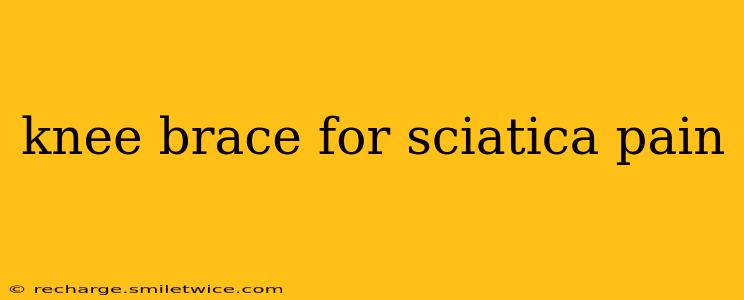Sciatica, that sharp, shooting pain radiating down your leg from your lower back, can be debilitating. While the pain originates in your spine, many people find that knee pain accompanies or even precedes sciatica symptoms. This leads to the question: can a knee brace help with sciatica pain? The short answer is: it depends. While a knee brace won't address the root cause of sciatica (nerve compression in the lower back), it might offer some relief in certain situations. Let's explore when a knee brace might be helpful and when it's likely to be ineffective.
How Could a Knee Brace Help with Sciatica?
A knee brace's potential benefit in sciatica isn't about directly treating the nerve compression. Instead, it can help manage secondary issues that often accompany sciatica:
- Knee Instability: Sciatica can cause weakness in the leg muscles, leading to knee instability and increased risk of falls. A knee brace provides support, improving stability and reducing the chance of further injury.
- Pain Management: The support and compression provided by a knee brace can help alleviate some of the pain felt in the knee area, even if that pain is referred pain from the sciatic nerve. This can be particularly helpful during activities that aggravate the knee joint.
- Proprioception: A knee brace can improve proprioception – your body's awareness of its position in space. This can be beneficial for individuals with sciatica who experience altered gait or balance due to muscle weakness.
- Reduced Inflammation: Some knee braces offer compression, which can help to reduce swelling and inflammation around the knee joint. While this won't address the nerve root issue, it can contribute to overall comfort.
What Types of Knee Braces Might Be Used?
Several types of knee braces could potentially offer relief, depending on the individual's specific needs and the nature of their knee pain:
- Hinged Knee Braces: Offer strong support and stability, particularly beneficial for those with significant knee weakness or instability related to sciatica.
- Sleeved Knee Braces: Provide compression and warmth, potentially reducing inflammation and pain. These are usually lighter and more comfortable for everyday wear.
- Wrap-Around Knee Braces: Offer adjustable compression and support, making them suitable for various levels of knee pain and instability.
Important Note: Always consult with a physical therapist or doctor before using a knee brace, especially if you're experiencing sciatica. They can help determine the appropriate type of brace and ensure it's being used correctly. Improper use could exacerbate the problem.
Does a Knee Brace Treat the Underlying Cause of Sciatica?
No. A knee brace does not address the root cause of sciatica, which is usually nerve compression in the lower back. It's crucial to understand that a knee brace is a supportive measure, not a cure. For effective treatment of sciatica, you need to address the spinal issue. This might involve:
- Physical Therapy: Exercises to strengthen core muscles, improve posture, and stretch tight muscles.
- Medication: Over-the-counter pain relievers or prescription medications to manage pain and inflammation.
- Injections: Epidural steroid injections or other types of injections to reduce inflammation around the nerve root.
- Surgery: In rare cases, surgery may be necessary to correct a severe spinal problem.
When Should I See a Doctor for Sciatica?
You should seek medical attention if your sciatica pain:
- Is severe or debilitating.
- Is accompanied by bowel or bladder dysfunction.
- Does not improve after a few weeks of home care.
- Is accompanied by numbness or weakness in your leg or foot.
Can Exercises Help Sciatica?
Absolutely! A tailored exercise program is often a cornerstone of sciatica treatment. Exercises can strengthen your core muscles, improve flexibility, and reduce nerve compression. However, it's essential to work with a physical therapist to develop a safe and effective exercise plan specific to your condition.
What are other treatments for Sciatica?
Besides the ones listed above, other treatment options for sciatica include:
- Chiropractic care: This involves spinal manipulation to adjust the spine and alleviate nerve compression.
- Massage therapy: This can help to relax tight muscles and reduce pain.
- Acupuncture: This involves inserting thin needles into specific points on the body to stimulate nerve pathways and reduce pain.
Remember, sciatica treatment should be comprehensive and address the underlying cause, not just the symptoms. While a knee brace might offer temporary relief from secondary symptoms, it's crucial to consult a healthcare professional for a proper diagnosis and treatment plan.
